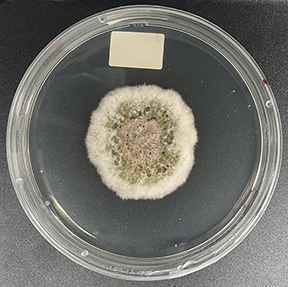
Image Credit: Kathryn Bushley
Within the framework of JGI “Community Sequencing Project: Defensive Mutualism of Fungal Root Endophytes of Soybean” CSP project, we are investigating the potential role of fungal endophytes isolated from soybean roots in protecting the plant from two devastating root plant pathogens: 1) the root rot fungus causing Soybean Sudden Death Syndrome (Fusarium virguliforme) and the soybean cyst nematode (Heterodera glycines). These fungi were screened for either anti-fungal or anti-nematode activity in-vitro and genome, transcriptome, and metabolome sequencing will address possible mechanisms of antagonism of these pathogens.
Setophoma terrestris, a member of Pleosporales in the Dothideomycetes, is a common soil fungi that causes pink-root rot in a number of different crops (e.g. onions, corn and others), although soybean is generally a poor or asymptomatic host (Yoshida, 2022). Setophoma terrestris has potentially antagonistic interactions with other soil organisms, inducing the bacterium Bacillus subtilis to increase production of antifungal metabolites (Albarracín Orio et al., 2020). Setophoma itself is known to produce bioactive natural product metabolites, including cytotoxic polyketides (El-Elimat et al., 2015). This fungus has also been isolated from the cysts of several species of cyst nematodes (Nyang'au et al., 2023, Oro et al., 2021).
Researchers who wish to publish analyses using data from unpublished CSP genomes are respectfully required to contact the PI (Dr. Kathryn Bushley) and JGI to avoid potential conflicts on data use and coordinate other publications with the CSP master paper(s).
References:
- Albarracín Orio, A. G., Petras, D., Tobares, R. A., Aksenov, A. A., Wang, M., Juncosa, F., Sayago, P., Moyano, A. J., Dorrestein, P. C. & Smania, A. M. 2020. Fungal-bacterial interaction selects for quorum sensing mutants with increased production of natural antifungal compounds. Communications Biology, 3, 9.
- El-Elimat, T., Figueroa, M., Raja, H. A., Graf, T. N., Swanson, S. M., Falkinham, J. O., Wani, M. C., Pearce, C. J. & Oberlies, N. H. 2015. Biosynthetically Distinct Cytotoxic Polyketides from Setophoma terrestris. European Journal of Organic Chemistry, 2015, 109-121.
- Nyang'au, M. N., Akutse, K. S., Fathiya, K., Charimbu, M. K. & Haukeland, S. 2023. Biodiversity and efficacy of fungal isolates associated with Kenyan populations of potato cyst nematode (Globodera spp.). Biological Control, 186, 9.
- Oro, V., Stanisavljevic, R., Nikolic, B., Tabakovic, M., Secanski, M. & Tosi, S. 2021. Diversity of Mycobiota Associated with the Cereal Cyst Nematode Heterodera filipjevi Originating from Some Localities of the Pannonian Plain in Serbia. Biology-Basel, 10, 13.
- Yoshida, N. 2022. Seasonal dynamics of the pink root fungus (Setophoma terrestris) in rhizosphere soil: Effect of crop species and rotation. Plant Pathology, 71, 361-372.
